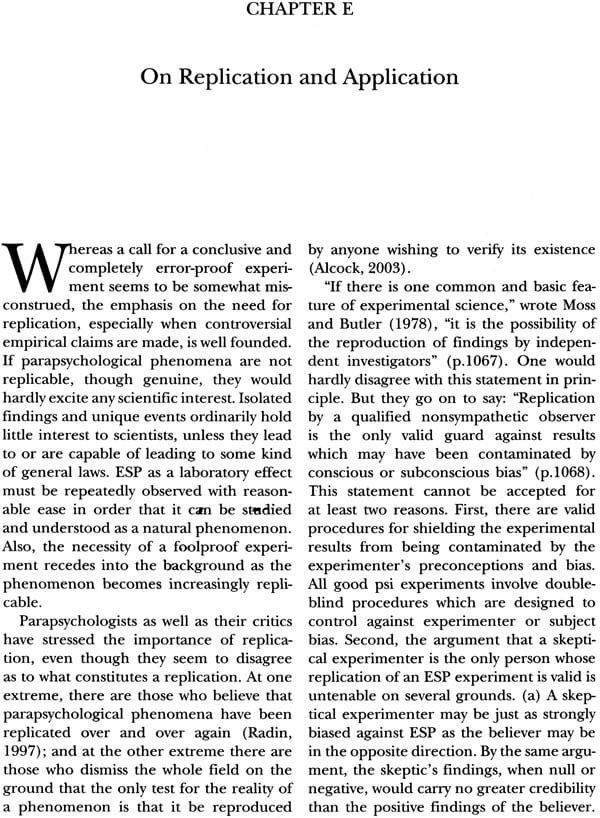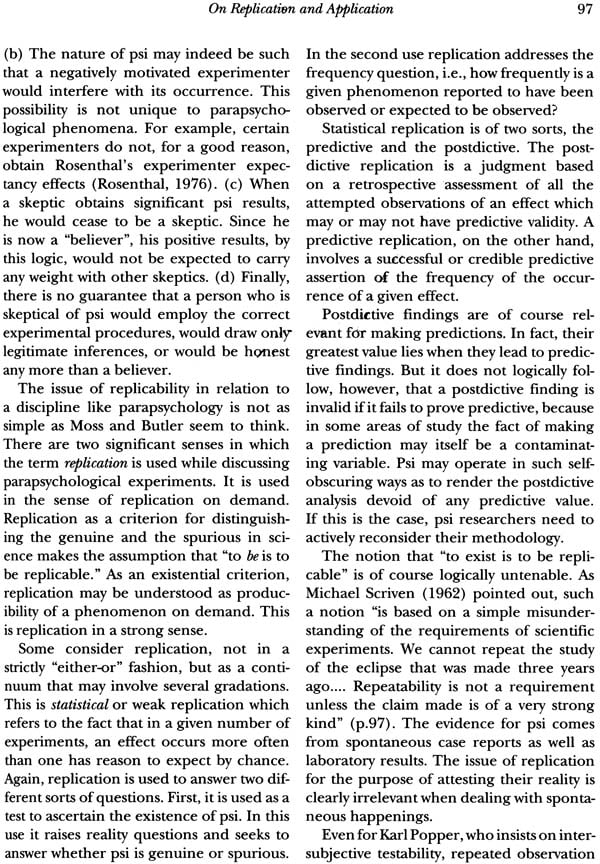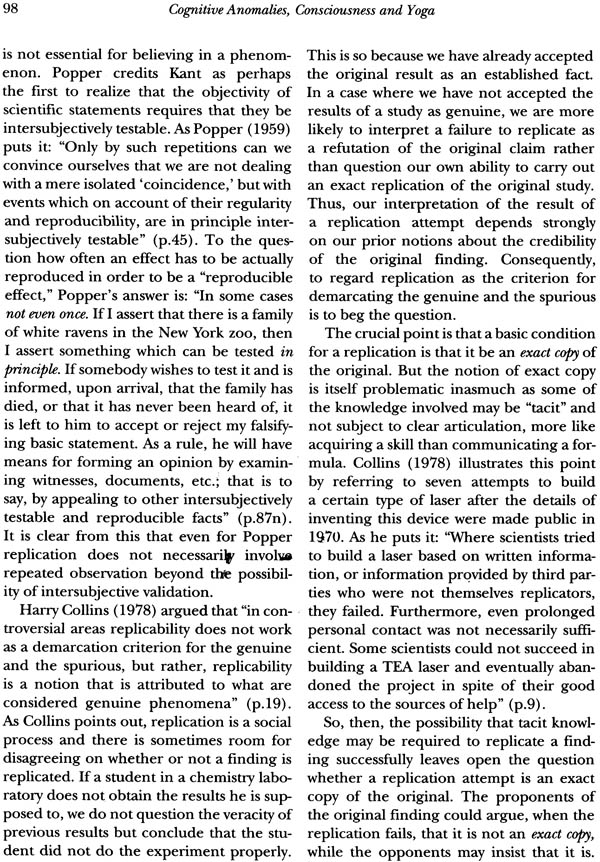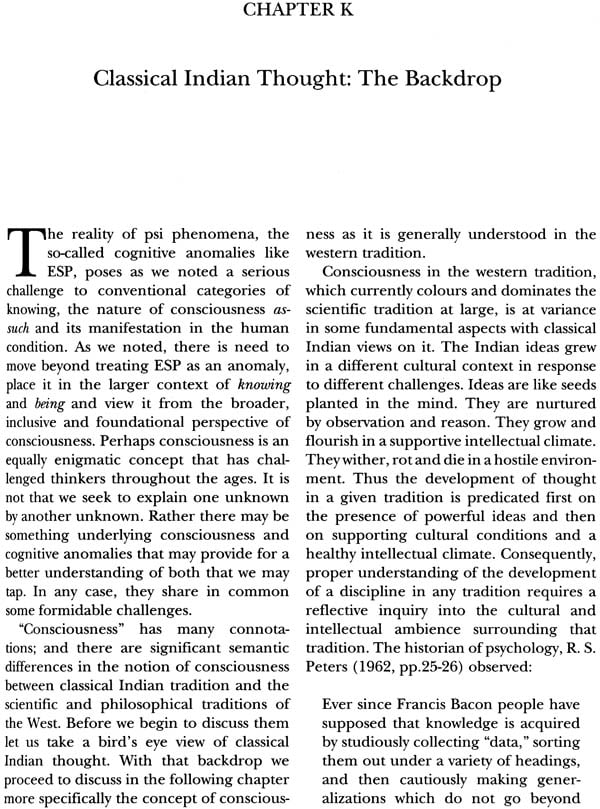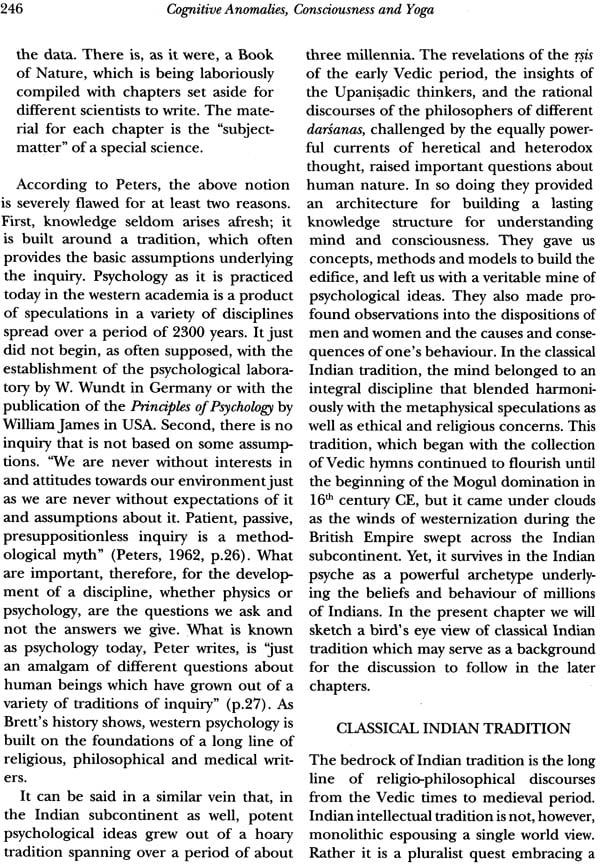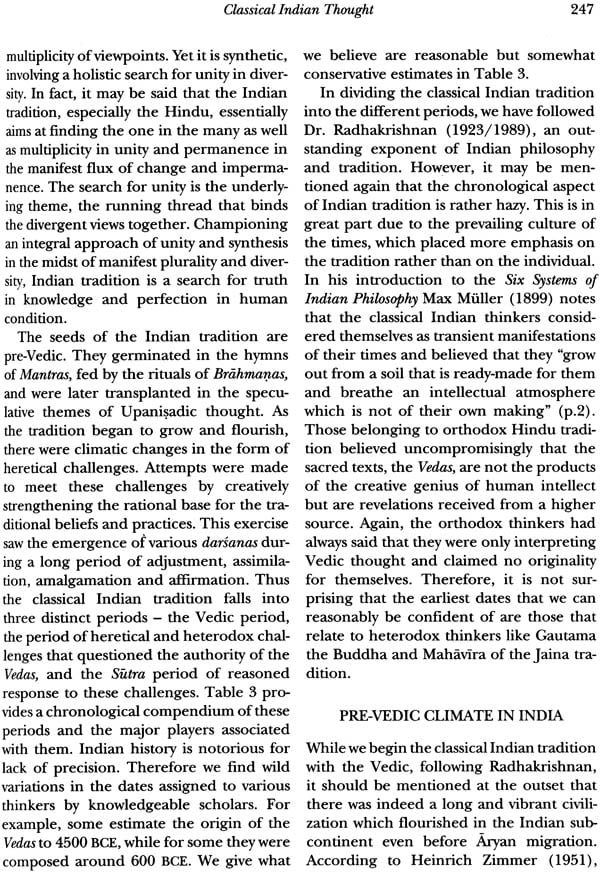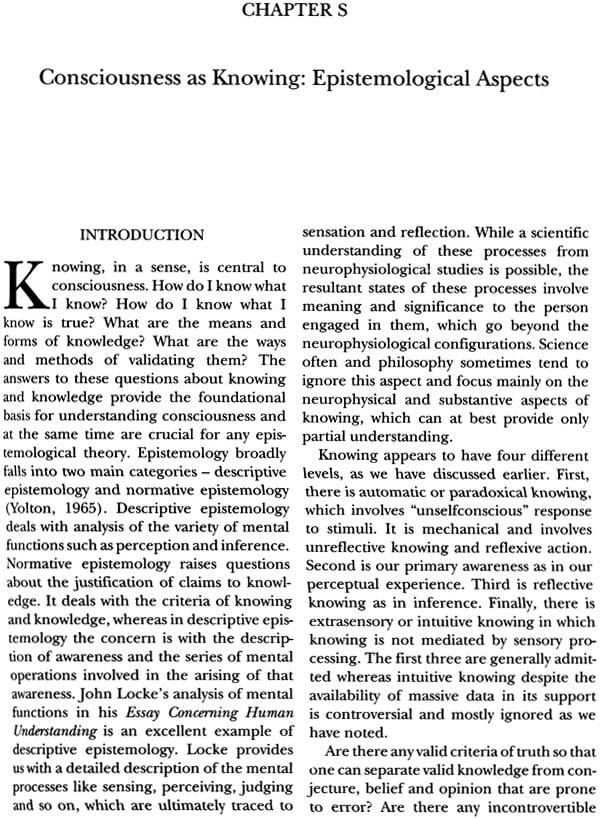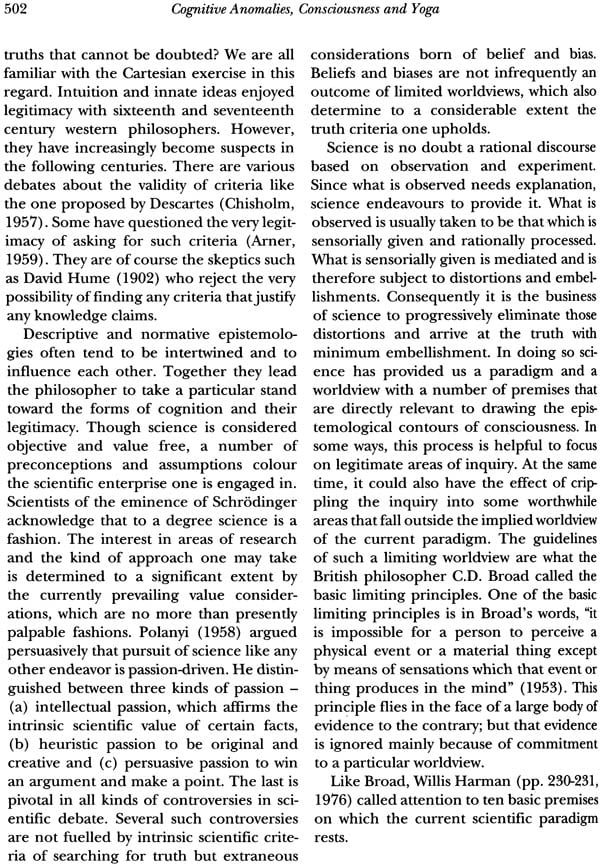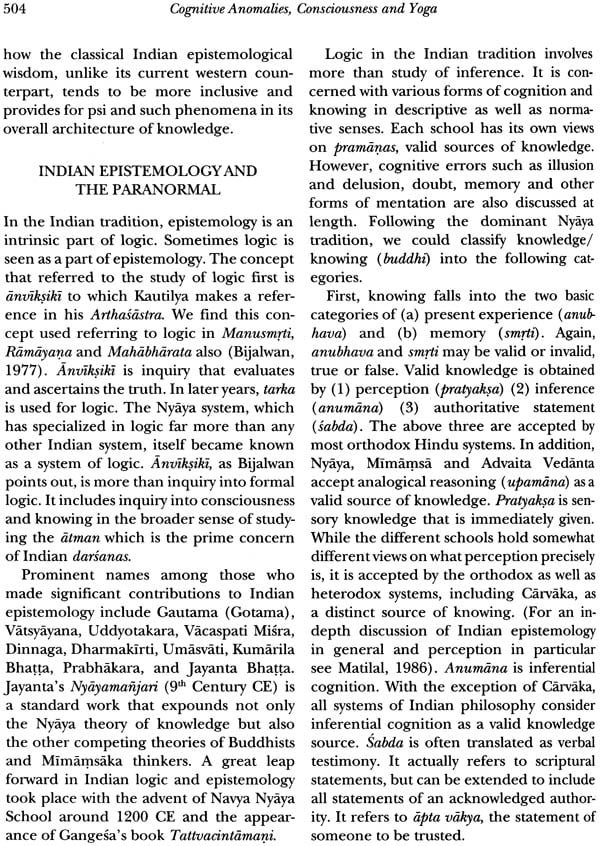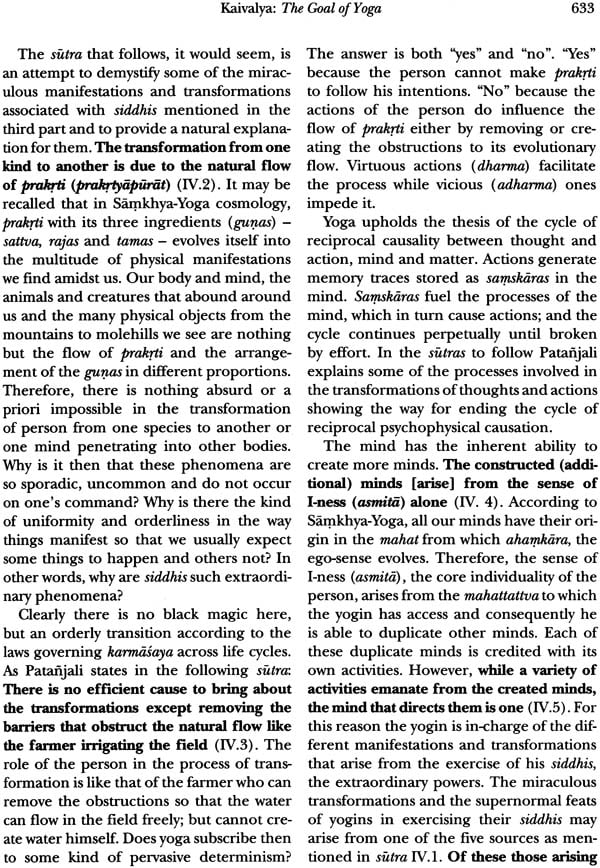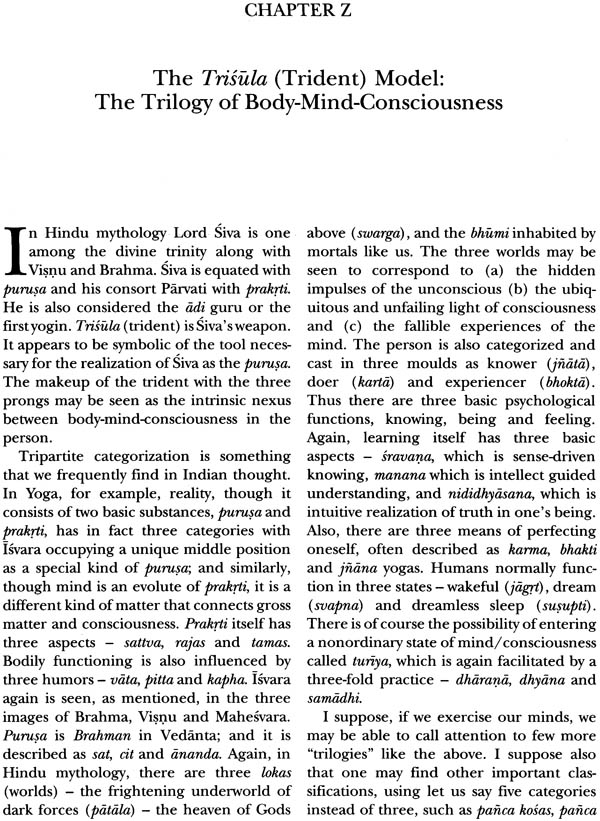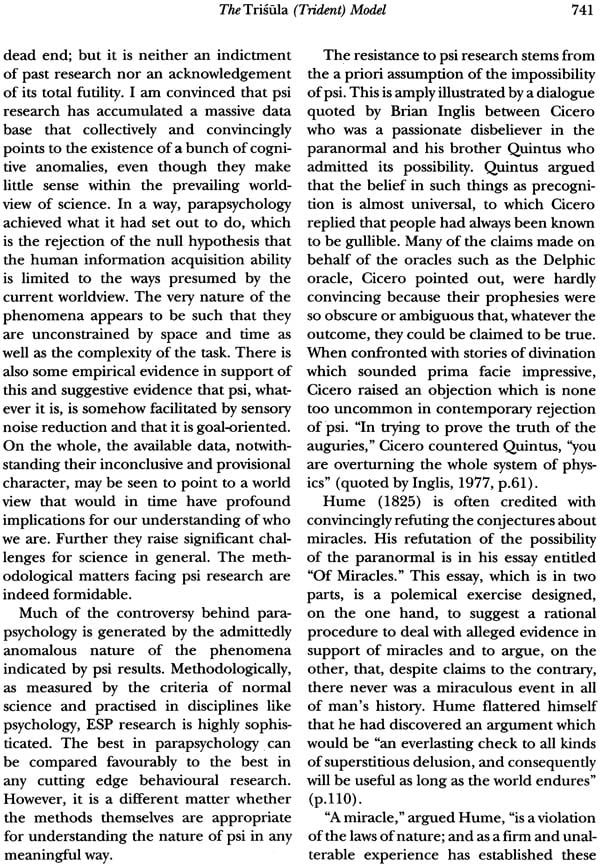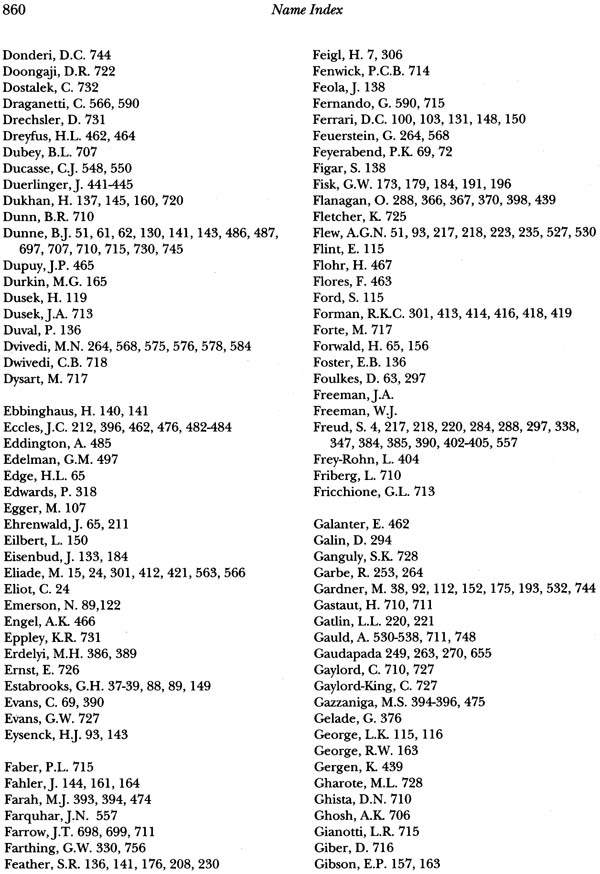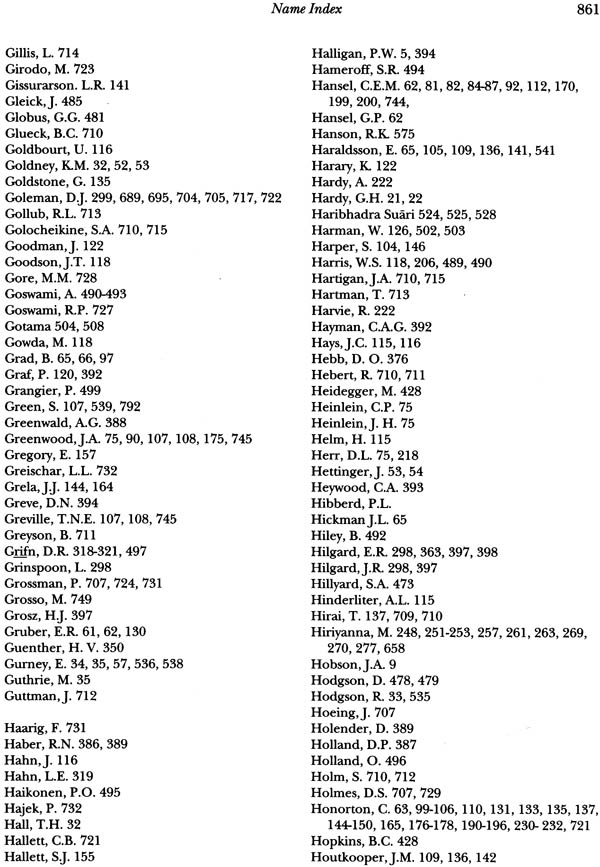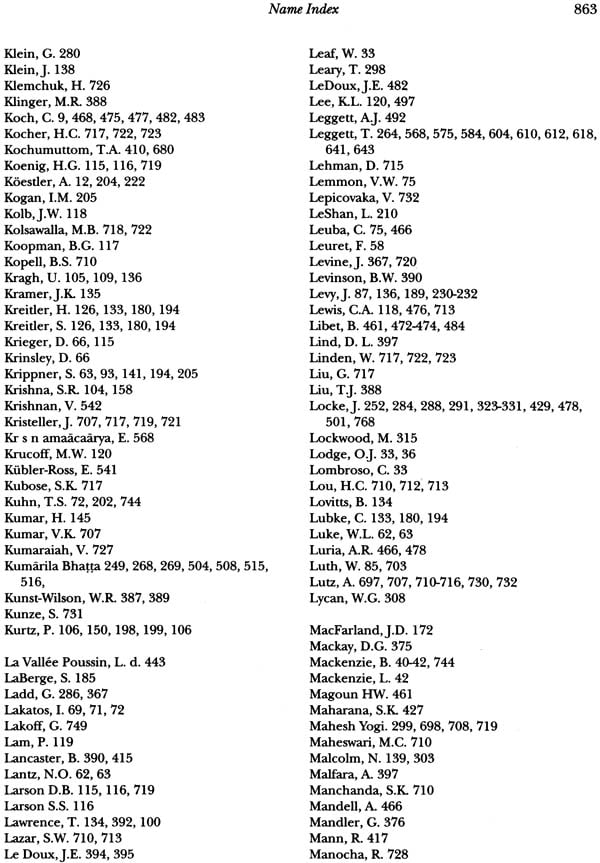
Cognitive Anomalies Consciousness and Yoga
Book Specification
| Item Code: | NAM127 |
| Author: | K. Ramakrishna Rao |
| Publisher: | Centre for Studies in Civilizations |
| Language: | English |
| Edition: | 2011 |
| ISBN: | 9788191014228 |
| Pages: | 906 |
| Cover: | Hardcover |
| Other Details | 11.5 inch x 8.5 inch |
| Weight | 2.40 kg |
Book Description
The volumes of the Project of History of Science, Philosophy and culture in Indian Civilization aim to discover the central aspects aspects of India’s heritage and present them in an interrelated manner. In spite of their unitary look, these volumes recognize the difference between the areas of material civilization and those of ideational culture. The Project is not being executed by a single group of thinkers, methodologically uniform or ideologically identical in their commitments, Rather, contributions are made by different scholars of diverse ideological and methodological approaches. The Project is by what may be called ‘methodological pluralism’. In spite of its primarily historical character, this project, both in its conceptualization and execution, has been shaped by scholars drawn from different disciplines. It is the first time that an endeavour of such unique and comprehensive character has been undertaken to study critically a major world civilization.
Cognitive Anomalies, Consciousness and Yoga is Professor Ramakrishna Rao’s magnum opus, a culmination of life-long efforts to develop a comprehensive model of the person that is inclusive of our rational, emotional and spiritual dimensions without reducing or converting one into another. Professor Rap brings his vast scholarship in eastern and western thought systems and his experience as a practicing scientist and psychologist for a unified understanding of human nature. His arguments move with ease from Upanishadic conceptions to current phenomenological and existential discourses on the mind and from quantum mechanics and particle physics to neural correlates of consciousness.
Professor Rao sets out in the book with the primary question who we are. Are we merely brain-driven machines? Is consciousness no more than a pack of neurons firing in synchrony? Is there anything in us that does not fit into the material framework of the universe and calls for paradigmatic shift in our search for a more inclusive universe?
These questions take him for an indepth discussion of paranormal phenomena, extraordinary human abilities. Pointing to the pervasive scientific evidence n support of such abilities that cannot be wished away as unreal artefacts of sloppy research nor explained adequately on materialistic/reductionist models, Professor Rao argues that the current research paradigms are simply inadequate to study these phenomena. Extensive discussions of current research on consciousness bring into focus certain aspects of consciousness that in principle appear to defy all attempts to explain them within the physicalist framework. Prominent among them is subjectivity, the “what is it like” feel of experience.
While acknowledging that physical models of the mind have contributed significantly to our understanding of cognitive abilities that they, however, leave many gaps in our knowledge of higher forms of consciousness. Professor Rao finds in Indian theories of mind and consciousness, especially Yoga, the necessary ingredients for a more comprehensive paradigm of human nature. From these ingredients, he develops the Trisula (Trident) model of the Person as composite of body, mind and consciousness. Body-Mind-Consciousness nexus in humans is conceived as a single unitary process, and yet one that takes on quantum jumps and qualitative leaps as we move on from bodily processes to mental experiences and to conscious phenomena. Consciousness and mind are independent and irreducible to each other, and yet are manifestations of the same process. The irreducibility aspect tends to lead us to mistakenly hypostasize them as noninteracting entities. Their origin from a single source gives us the temptation to reduce them into a single category. Cognitive Anomalies, Consciousness and Yoga are three books in one. Each part can be read as separate and distinctive. However, together they give a comprehensive picture of the person. This, indeed, is a source book of serious ideas that could provoke much further discussion and research
D.P. Chattopadhyaya, MA LLB, Ph. D (Calcutta and London School of Eeconomics), D. Litt (Honoris Causa) studied and researched on law, philosophy and history, and taught at various universities in India, Asia, Europe and USA from 1954 to 1994. Founder Chairman of the Indian Council of Philosophical Research (1981-1990) and President-cum-Chairman of the Indian Institute of Advanced Study, Shimla (1984-1991), Chattopadhyaya is currently the Project Director of the Project of History of Indian Science, Philosophy and Culture (PHISPC) and Chairman of the Centre for Studies in Civilizations (CSC). Among his 36 publications, of which he has authored 18 and edited or co-edited, are Individuals and Societies (1967); Individuals and World (1976); Sri Aurobindo and Karl Marx (1988); Anthropology and Historiography of Science (1990); Induction, Probability and Skepticism (1991); Sociology, Ideology and Utopia (1997); Societies, Cultures and Ideologies (2000); Interdisciplinary Studies in Science, Society, Value and Civilizational Dialogue (2002); Philosophy of Science, Phenomenology and Other Essays (2003); Philosophical Consciousness and Scientific Knowledge: Conceptual Linkages and Civilizational Background (2004); Self, Society and Science: Theoretical and Historical Perspectives (2004); Religion, Philosophy and Science (2006) and Aesthetic Theories and Forms in Indian Tradition (2008). He has also held high public offices, namely, of Union cabinet minister and state governor. He is a Life Member of the Russian Academy of Science and a Member of the International Institute of Philosophy, Paris. He was awarded the Padma Bhushan in 1998 and the Padma Vibhushan in 2009 by the Government of India.
K. Ramakrishna Rao, Ph. D, D. Litt is a philosophers, psychologist and educationist with vast experience in national and international arena as a teacher, researcher and administrator.
An acknowledged international authority on Indian psychology, consciousness studies and parapsychology, Prof. Rao has published nearly two hundred research papers and fifteen books, the most recent ones include Consciousness Studies: Cross-Cultural Perspectives (McFarland, 2002), Towards a Spiritual Psychology edited with S.B. Marwaha (Samvad, India, 2005), Handbook of Indian Psychology edited with Anand Paranjpe and Ajit Dalal (Foundation Books, Cambridge University Press, 2008), and the recent Yoga and Parapsychology: Empirical Research and Theoretical Essays (2010, edited). He was Founder-Head and Professor, in the Department of Psychology and Parapsychology and Honorary Director of the Institute for Yoga and Consciousness at Andhra University. Dr Rao worked with Dr J. B. Rhine at Duke University and later headed his Foundation for Research on the Nature of Man as its Executive Director.
In addition to teaching and research Prof. Rao served in several top level administrative, executive and advisory positions. These include Vice-Chancellor of Andhra University, Chairman of the A.P. State Commissionerate of Higher Education and Founder President of the Institute for Human Science and Service.
Professor Ramakrishna Rao served as the editor of Journal of Indian Psychology and Journal of Parapsychology. He was elected as the President of the Parapsychological Association, an international professional body of scientists based in USA, on three different occasions. Dr. Rao was also elected President of the Indian Academy of Applied Psychology during two consecutive terms. Currently the Chairman of the Indian Council of Philosophical Research and President of the Asian Congress of Philosophy, Prof. Rao numerous national and international honors and recognition for his work, which include Doctor of Letters (Honoris Causa) degrees from Andhra and Kakatiya Universities and Doctor of Science (Honoris Causa) degree from Acharya Nagarjuna University.
On this day fourteen years ago, a political star had fallen in this part of the world. Sri N. T. Rama Rao, former Chief Minister of Andhra Pradesh, popularly known as NTR died, leaving millions of his fans, followers and friends in shock and sorrow. I was equally traumatized. He my mentor in public life.
I returned to India in 1994 after a long sojourn in the US and joined NTR’s government to head Andhra Pradesh State Planning Board soon after he took office again as the Chief Minister, expecting to spend the rest of my life in public service. Until then I was a teacher, researcher and academic administrator. I felt that leaving the US was the end of that journey and the beginning of a new life of public service in India. Alas! It was all too short! I was not into politics and was never a member of a political party. My entry into public life was entirely because of the persuasion of NTR. With his passing that journey ended somewhat abruptly in 1996. Since I belonged to no party, had no political roots, and indeed no political ambitions, it is natural that I returned to my first love, reading and writing. So the day of NTR’s death was the day of my academic rebirth. It took about five years to retool myself as an academic. With the dawn of the new millennium came into being the Institute for Human Science & Service (IHSS) in Visakhapatnam; and I was back in the saddle to ride a new academic horse. As my wife says, I have since been more active and busy than I ever was working full time seven days a week. The only difference is that by choice I do not get paid for what I do now. These have been truly satisfying years of high academic productivity. During the past eight years, in addition to heading the IHSS and more recently the Indian Council of Philosophical Research (ICPR), I have been quite active writing and lecturing. I published five books: Basic Research in Parapsychology (Rao, 2001), Consciousness Studies: Cross-Cultural Perspectives (Rao, 2002), a book I dedicated to NTR, Towards Spiritual Psychology (Rao & Marwaha, 2005), Handbook of Indian Psychology (Rao, Paranjpe & Dalal, 2008) and Yoga and Parapsychology (Rao, 2010). There were over dozen research papers and book chapters and too many seminar and conference presentations that i lost count of.
The Present book, the sixth since my rebirth, is the culmination of eight years of effort to synthesize my three-fold academic pursuit the areas of parapsychology, consciousness studies and Indian psychology. In a way, this volume is a trisula (trident) with three prongs, paranormal phenomena, yoga and consciousness studies. Thus what we have here are three books in one, with each part devoted mainly with one area-Part I with Parapsychology, Part II with consciousness studies and Part III with Yoga and Indian psychology. The first chapter, the prologue, raises the core issues that prompted me to undertake this study; and the concluding chapter is a synthetic statement of where we stand now with a brief preview of the Trident (trisula)model of the person, soon to be developed into a more comprehensive system with empirical implications for research in Indian psychology. I recognize that there are occasions where the same idea is repeated. For example, we refer to Gilbert Ryle’s refutation of radical dualism more than once. We emphasized on several occasions the fact that in Indian thought there is a fundamental distinction made between mind and consciousness, which is missing in the western discussions. Also, I have attempted to bring different perspective on the same subject on different occasions as, for example, when we discussed yogic siddhis in Chapters S and V. Considering the size of the book, the variety of topics and the changing contexts, we feel that the repetitions are warranted. I hope the reader would find them helpful and not annoying, reinforcing rather than distracting.
The initiative and inspiration for writing this book came out of a meeting with Dr. Kireet Joshi, my predecessor Chairman of the ICPR at a meeting in Pondicherry during the end of 2002. Dr. Joshi introduced me to Dr. D.P. Chattopadhyaya, who graciously saked me to be an editorial fellow in their Project of History of Indian Science, Philosophy and Culture (PHISPC) and undertake the publication of a book in their series of books on Yoga. Most of the publications brought out under the aegis of PHISPC are edited volumes. However, I chose to write the entire book myself; and the work began in the year 2003.
When I took charge as the Chairman of the ICPR in June 2006, I requested Professor Chattopadhyaya to relive me as the editorial fellow, with the Promise that I would complete the book without further support from the PHISPC. So it took me almost three years after that to fulfill my promise and place the manuscript of the book in his hands. I greatly appreciate the cheerful patience shown forgiving my delay. The major Part of the book was written after I ceased to be the fellow of PHISPC. I thank Dr. Kireet Joshi and Dr. D.P. Chattopadhyaya for entrusting this important work to me and their support and encourage ment throughout this period. I also express my gratitude to Dr. Bhuvan Chandel, the Coordinator of PHISPC, for her interest and involvement. I had the benefit of comments of a number of colleagues around the world who real the manuscript of the book in whole or in parts. Those who read Part I include Dr. H. Kanthamani, Dr. H. Hanumantha Rao and Prof. P. V. Krishna Rao, with whom I have been associated in various roles for nearly forty years. I am deeply beholden to them not only for their comments on the manuscript but also their continued academic support over the years. James E. Kennedy, a friend and colleague at the Institute for Parapsychology in Durham, N.C. when I was the Director, gave me several insightful suggestions and I am thankful to him.
My academic twin brother Professor Anand Paranjpe of Simon Fraser University, despite his very busy schedule and other health-related challenges found time to read the entire manuscript. I gratefully acknowledge his inputs. I am equally indebted to Professor Max Velmans of Goldsmiths, University of London, and leading researcher in the area of consciousness studies for his Foreword introducing the book to western readers. He meticulously went through the entire manuscript and made incisive comments which helped to bring clarity, especially to Part II and the final chapter.
Among other who read the manuscript are Professor S.R. Bhatt, former professor of philosophy at Delhi University, Professor Godabarisha Mishra, Member-Secretary, ICPR, Professor Gayatri Devi, Professor of Sanskrit, Andhra University, and Professor Peter Sedlmeier, Professor of psychology, Chemnitz University, Germany. My thanks to them and several other colleagues from whom I learned in the course of discussing some of the contents of this book. While the book is much better because of the inputs received from all these people, whatever shortcomings that remain are obviously my own.
In writing this book I have drawn heavily from my previous publications, especially from the book Consciousness Studies: Cross-Cultural Perspectives. It was not possible to acknowledge at every point. Therefore, I make a general acknowledgment thanking Mr. Robert Franklin, President, McFarland & Co, publishers of several of my books, for allowing me to freely use my earlier published material. Also, I had the Privilege of presenting portions of the contents of the book at various national and international forums. Some of them were published by the respective organizations. I thank them for the opportunity to present these papers. I was benefited by the discussions that followed.
I acknowledge with thanks the secretarial assistance I received from Sri U. Sadasiva Rao in preparing this volume. In a way, his help was more than typing. He has the eye for detail and he brought to my attention on several occasions some errors that inadvertently found their way into the manuscript. Last, but by no means less important, is the help I received throughout the preparation of this manuscript from my colleague at the Institute for Human Science & Service, Dr. Sonali Bhatt Marwaha. Sonali is an amazing person. Cheerfully suffering her own health challenges, she shared hertime ungrudgingly to help to me whenever I needed her help. She indeed oversaw the preparation and publication of this volume. I am deeply beholden to her. In beginning the review of one of my earlier books Douglas Stokes (2002) wrote: “Judging from his just published book, Consciousness Studies: Crooss-Cultural Perspectives, Ram is just getting started” (p.182). The present bbok is continuation of that journey. I hope I made some headway and covered a significant distance. I know that there is much further to go. I look forward to the feedback from the readers if I am on the right course that would lead us to get some true glimpses of who we are and where we are headed.
It is said that Ancient Greek Temple of Apollo at Delphi bore the inscription (gnothi seauton). Know thyself! This quest has been at the heart of philosophical, scientific and personal explorations both in the East and in the West over the millennia.
However the methods used to acquire reliable knowledge of the human Self in the East and in the West have been rather different. In the West, particularly in science, methods of exploration have largely focused on developing refined tools for investigating how the physical world appears when viewed from the outside, using third-person methods of investigation. Viewed from this perspective alone, the human Self appears to be part of the natural world and human nature appears to be entirely governed by the interactions of the embodied brain with external and internal physical events. Given this orientation, Western philosophy of mind and Western theories of consciousness have become largely, although not exclusively, materialist reductionist. From an external, third-person perspective one cannot view the conscious experiences of other human beings, only the workings of their brains. Consequently many contemporary Western theories of consciousness have tried to argue that conscious experiences are nothing more than the working of brains.
Eastern methods for exploring the human Self have, by contrast, focused on exploring consciousness and the workings of mind from a first-person perspective, for example by developing techniques for the refinement and stabilising of attention. Such training of the mind alters the habitual workings of the mind, with consequent effects on what the mind experiences. Following such practices many Eastern investigators have found that, once the mind is stabilised and no longer distracted by the senses, the normal play of phenomenal experiences subsides, thereby revealing a ground state within which those experiences take place, variously described as consciousness-as-such, or a pure, (content-less) consciousness experience. Those who have experienced this state report that it is accompanied by a conviction that, “I am that” (soham in the Vedas). Given this, it is not surprising that in various Eastern philosophies and psychologies, consciousness-as-such is thought to be the essence of the human Self.
With the advent of a more globalised culture these Eastern and Western traditions no longer develop in isolation. The East, hungry for the material benefits of Western science and technology has now adopted it as its own. The West, hungry for a richer understanding and experience of what it is to be an embodies, conscious being in the world has become increasingly open to experimenting with Eastern meditative techniques. However this leaves a philosophical tension. The relations between body, brain, mind and consciousness in which the material world is thought of as the basis of everything would seem to be very different one in which consciousness as such is the basis of everything. It is within the context of this tension that this major work by K. Ramakrisna Rao searches for more holistic unifying view.
In many ways Rao is uniquely qualified. Born in India, trained in both Eastern and Western philosophy and psychology, Rao has spent much of his academic career exploring the edges of knowledge, for example in his work with J.B. Rhine in the parapsychological laboratory at Duke University in the USA, and Founder, Head and Professor of the Department of Psychology and Parapsychology, and Honorary Director of the Institute for Yoga and Consciousness at Andhra University. He has nearly two hundred research papers and thirteen books, covering topics that range from Eastern psychology and philosophy, to parapsychology, and to western consciousness studies. This vast scholarship is much in evidence in this book.
Drawing together these wide-ranging endeavours, this book is really three books in one. Part I with parapsychology, Part II with consciousness studies and Part III with Yoga and Indian psychology. All the great questions are examined. Is the universe composed of one underlying reality (monism) or are there two (dualism)? Is the physical world the foundational reality, consciousness the foundational reality, or are both equally fundamental? Is consciousness separate from mind, and is mind separate from brain? What is the nature of the human Self-if there is such a Self? What if anything might endure when the body dies? Given the nature of the human condition and the relation between consciousness, mind and brain how might it be possible to transform human nature to realize its full potential? Rao reviews the state of play in each area dispassionately, sifting through the rich soil to find the gold nuggets. This is no easy matter. As he makes clear, parapsychology has some intriguing findings but also some special research problems, and Eastern philosophy and psychology have as many controversies about the fundamental nature of mind, consciousness and the nature of Self as do Western philosophy and consciousness studies. In spite of this, beneath it all, there are connecting threads, and the beginnings, perhaps, of a unifying view that Rao develops. In this he draws heavily on Samkhya Yoga and Advaita Vedic philosophy, which, in spite of their antiquity may have a unique contribution to make to our search for who really are. In our individual human journeys, nothing could be of greater importance.
| Preface | ||
| Foreword | ||
| Max Velmans | ||
| A | The Issues | 3 |
| | ||
| B | Parapsychology: The Birth of a Brave New Science | 19 |
| C | Cognitive Anomalies: Scope and Subject Matter of Parapsychology | 43 |
| D | The Matter of Evidence | 74 |
| E | On Replication and Application | 96 |
| F | What Do We Know About Psi? | 130 |
| G | The Nemesis of Psi-Missing | 149 |
| H | Anathama of the Experimenter Effect | 170 |
| I | The Explanatory Quagmire | 198 |
| J | Conundrums of Cognitive Anomalies: Postscript to Fifty Years in Parapsychology | 225 |
| | ||
| K | Classical Indian Thought: The Backdrop | 245 |
| L | Enigma of Conciousness and Its Ontology In the Western Tradition | 284 |
| M | Consciousness in Indian Tradition | 332 |
| N | Cognitive Consciousness | 362 |
| O | The Cognitive Unconscious | 384 |
| P | The Unconscious and Consciousness As-Such | 402 |
| Q | Mind, Self and Personal Identity: The Matter of Continuity of Consciousness | 423 |
| R | Physiology and Physics of Consciousness: The Mechanics of Awareness | 460 |
| S | Consciousness as Knowing: Epistemological Aspects | 501 |
| T | The Final Forntier: The Road Mad of Reincarnation | 529 |
| | ||
| U | Yoga as Samadhi | 563 |
| V | Practice (Sadhana) and Powers (Siddhis) Of Yoga | 592 |
| W | Kaivalya: the Goal of Yoga | 632 |
| X | Yoga: A Psychology of the Future | 662 |
| Y | Applied Psychology of Yoga: A Review of Research on Meditation | 685 |
| Z | The Trisula (Trident) Model: the Trilogy of Body-Mind- Consciousness | 739 |
| Glossary | 785 | |
| References | 801 | |
| Name Index | 857 | |
| Subject Index | 871 | |
